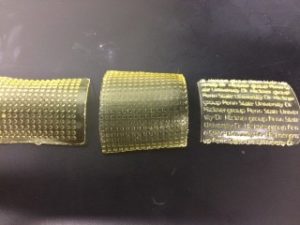 Ion exchange membranes, which are flat sheet-like materials that transport dissolved ions across a conductive polymeric membrane, are utilized in variety of energy applications. Used in fuel cells, particular batteries, water purification, desalination, food processing and much more, these membranes work to transport ions from one solution to another. Researchers from Penn State University’s Department of Materials Science and Engineering have just developed a new type of 3D printing process that is aimed at enhancing the hydrodynamic properties of these membranes, which would lead to improved ion transportation and mitigate fouling.
Ion exchange membranes, which are flat sheet-like materials that transport dissolved ions across a conductive polymeric membrane, are utilized in variety of energy applications. Used in fuel cells, particular batteries, water purification, desalination, food processing and much more, these membranes work to transport ions from one solution to another. Researchers from Penn State University’s Department of Materials Science and Engineering have just developed a new type of 3D printing process that is aimed at enhancing the hydrodynamic properties of these membranes, which would lead to improved ion transportation and mitigate fouling.
The most efficient way to enhance these properties is to make the membranes patterned, or profiled, which is traditionally done with a painstaking technique that involves etching a silicon mold with the desired pattern, pouring in the polymer, and waiting until it hardens. Even then, the outcome of this time-consuming and cost-prohibitive process is a single pattern type, which still brings about limitations in the functioning of the membrane.
 The Penn State research team has developed a unique 3D printing technique to help enhance the properties of these ion exchange membranes. To place performance enhancing 3D patterns onto these 2D membranes, the researchers created a custom 3D photolithographic printing process, which is conceptually similar to stereolithography. The process involves a photocurable mixture of ionic polymers, which is exposed under a light projector that hardens the base layer. More polymer is then added to the base layer, which is selectively hardened using a projected pattern. The result of the process is a surface pattern that increases the conductivity of the membrane by as much as a factor of two or three.
The Penn State research team has developed a unique 3D printing technique to help enhance the properties of these ion exchange membranes. To place performance enhancing 3D patterns onto these 2D membranes, the researchers created a custom 3D photolithographic printing process, which is conceptually similar to stereolithography. The process involves a photocurable mixture of ionic polymers, which is exposed under a light projector that hardens the base layer. More polymer is then added to the base layer, which is selectively hardened using a projected pattern. The result of the process is a surface pattern that increases the conductivity of the membrane by as much as a factor of two or three.
By utilizing 3D printing to help fabricate custom-synthesized ion exchange membranes, the research team is able to rapidly produce whichever pattern they need to enhance the hydrodynamic properties and improve the function of the membrane. According to Jiho Seo, a PhD candidate in materials science and engineering and the lead author of this recent study, this is the first known example of using 3D printing to help create patterned membrane structures.
“While surface patterned membranes have been studied previously, this is the first 3D printed example of these structures and the first model that really explains the resistance decrease in a quantitative way,” Seo said. “A simple parallel resistance model describes the effect of the pattern on lowering the resistance of these new membranes. This insight gives us a design tool to continue to innovate and create new patterns for further improvements along with changing the intrinsic chemistry of the material.”
The research findings were recently published in the American Chemical Society’s journal ACS Applied Materials and Interfaces, entitled “3D Printing of Micro-patterned Anion Exchange Membranes.” Supervised by Michael Hickner, Associate Professor of Materials Science and Engineering at Penn State, the research team will continue to investigate the different geometries and chemistries of the membranes they produce, and will also work on printing with new materials, both related to this membrane research and beyond. Aside from Seo and Hickner, PhD student Douglas Kushner also contributed to the published research. Discuss this project over in the 3D Printed Membranes forum at 3DPB.com.
Subscribe to Our Email Newsletter
Stay up-to-date on all the latest news from the 3D printing industry and receive information and offers from third party vendors.
You May Also Like
Nylon 3D Printed Parts Made More Functional with Coatings & Colors
Parts 3D printed from polyamide (PA, Nylon) 12 using powder bed fusion (PBF) are a mainstay in the additive manufacturing (AM) industry. While post-finishing processes have improved the porosity of...
3DPOD Episode 193: Flow and What’s Possible in 3D Printing with Ricky Wildman, University of Nottingham
Ricky Wildman is working on 3D printing pills, but, as Professor of Multiphase Flow and Physics at Nottingham, he does a whole lot more. His research encompasses the characterization of...
3D Printing Webinar and Event Roundup: March 17, 2024
It’s another busy week of webinars and events, including SALMED 2024 and AM Forum in Berlin. Stratasys continues its in-person training and is offering two webinars, ASTM is holding a...
3D Printed Micro Antenna is 15% Smaller and 6X Lighter
Horizon Microtechnologies has achieved success in creating a high-frequency D-Band horn antenna through micro 3D printing. However, this achievement did not rely solely on 3D printing; it involved a combination...






























